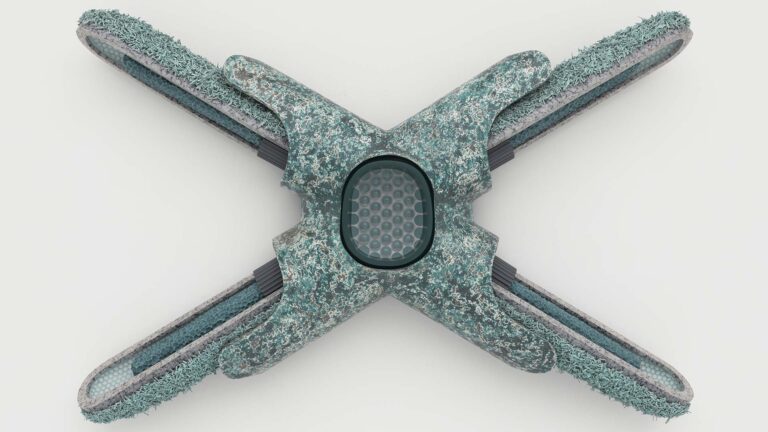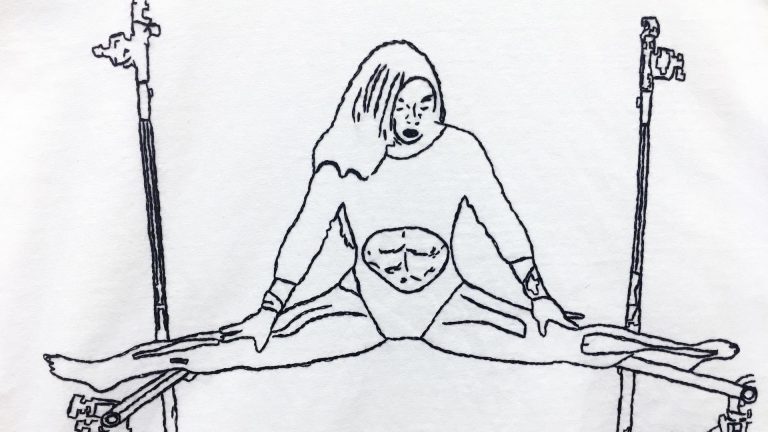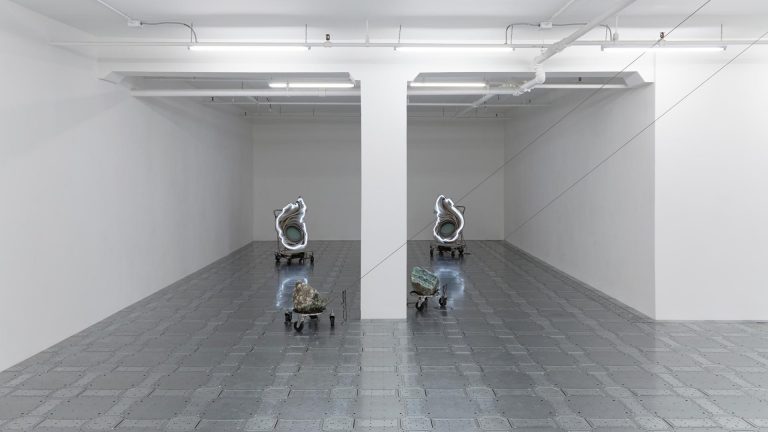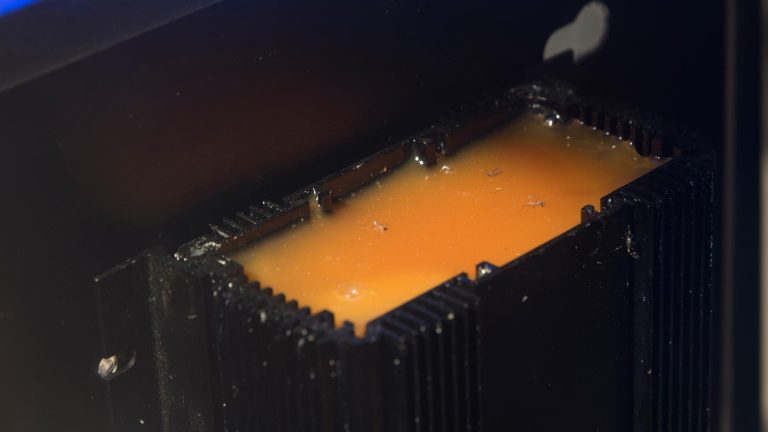Artist: Jessica Diamond, Arnold J. Kemp, Kayode Ojo, Arthur Simms, Alexandria Smith
Exhibition title: Lost & Found
Venue: Martos Gallery, New York, US
Date: February 5 – March 13, 2021
Photography: images copyright and courtesy of the artist and Martos Gallery, New York
A Lost & Found is a room where items that have gone astray are turned in and stored to await being claimed by their owners. Though all sorts of things are lost, simple representations of a hat, an umbrella and a glove are featured on signs seen in train stations or recalled from a scene in an old movie, usually a mystery. Signage meant to be more universally recognized pictures an umbrella and a small suitcase below a question mark, or a question mark overlaid on a suitcase, as in airport terminals worldwide. Signs will also simply announce Lost Property, uniting ownership and object orphandom in terms of belongings. Attendants are trained to be helpful, even empathetic, since those they briefly meet across the counter may be in a state of distress or agitated anticipation, hopeful that their missing items will magically appear from the inner recesses of the Lost & Found, a room many of us have been curious about since childhood. The attendant, for those in search of items absentmindedly left behind, and possibly for themselves, depending on the level of drama and its outcome, may briefly reign as the hero who saves the day. The child reunited with a beloved stuffed pal who slipped from sleepy arms unnoticed, wipes away big tears to manage a tentative, dampened smile. Such an ending also acknowledges its opposite, when an attendant returns empty-handed, or its inversion, when the happier end may have been conspired. Just the other day a friend related being with a man who, seeing a sign for a Lost & Found, went over, hoping to retrieve a pair of gloves. He described them to the attendant, being sure to mention they were of high quality, and black. When a very nice pair of gloves was soon brought out, he lit up, identified them, offered his thanks, and they went on their way. Moments after leaving, he told the woman that in fact he had never lost any gloves, quite satisfied with himself having acquired an expensive pair for free. Whether or not this story has any correspondence with our current situation, societally speaking, the image of a man’s clenched fist encased in a black leather glove, is entirely up to the reader.
What is the Lost & Found in art? Is there such a place? Is it a state of mind, of curiosity? Existing everywhere at all times? To occasion, over and again, a parallel with life, its flow? The tide comes in and the tide goes out, and what washes up randomly upon the shore? As many go about putting a lost year behind us, we wonder how to find our way back to ourselves, to one another, to those gone. Belongings. What belongs to us, and to whom do we belong? Can a gallery be thought of as a Lost & Found? Artists have long engaged with things discovered by chance, explored the assisted ready made and unmade by plan, have collected objects as well as words, the dual poetics of recycling, articulated a visual language of their own device or translation. We know that more items in a Lost & Found will remain unclaimed than encounter reunion. Such a place becomes an archive of sorts, forgotten items lining the shelves and racks, left behind absent-mindedly, perhaps intentionally? Beyond the usual books, bags, wallets and phones, items more commonly gone astray, others more rare will appear, to evoke the performative: a surfboard, a violin laid in its velvety case. Travelers who have arrived at their destinations, far from points of departure, can’t easily cross the air terminal or station concourse once they’re miles away; only upon arrival do many discover something’s gone. And what about the taking of an item that belongs, or belonged, past tense, to someone else? Rather than a purloined letter, a pair of gloves, disembodied as it were, handed over just like that (more readily than a watch or a ring), not stolen exactly, but deceptively acquired. To lose one’s train of thought is not necessarily a misfortune, for it’s in those unexpected turns that we derive the greater surprise, finding our way through an unfamiliar route taken. How did we get here? and Who are we now? This somewhat circuitously brings to mind a short, free-associative text from a time long past, a time before identity theft:
“I’ve been told by the authorities here to ‘write about art please you’re supposed to be the art critic.’ Well, that’s right and I don’t see why there’s a problem. Richard Kostelanetz just called me up to remind me of the Meredith Monk and Yvonne Rainer dance programs in February at the Billy Rose Theatre. I think Rainer is doing the most intelligent things that could happen in dance today. Someone called Saul Ostrow sent me a carbon copy of a letter which said only: I AM NOT NOR HAVE I EVER BEEN GREGORY BATTCOCK. That’s very frightening and reminded me of what Jill Johnston said in last week’s Voice about taking a subway ride and ending up in the lost and found …”[1]
Among the works in this exhibition, whose naming itself may be considered in some sense an invitation to become purposefully, pleasurably lost:
Jessica Diamond, Is That All There Is?, a wall painting from the Orwellian year of 1984 (a book written in 1948) that presents an image of the world, all of the continents, in a diminutive scale in relation to the large, wide text above, and to us before the oceanic wall. Given the endangered state of the planet today, climate change, hotter temperatures, rising seas, caused and accelerated by our actions and inaction, many would answer: Yes, that’s all we have. Let’s not destroy it so cavalierly. When this work was initially conceived, the artist may not have had any idea of a world so imperiled more than thirty years later, but here we are, and her work continues to resonate, as all engaged art does, for troubled times. Diamond must also have had in mind the signature song of Peggy Lee, which registers a world-weary resignation to disappointment, its inevitability—a lassitude within latitudes?—which asks, in childhood reminiscence: Is that all there is to a circus?
Arnold J. Kemp, two formidable canvases presented side-by-side, composed of spidery webs, entangled, layered lines, black on black, depth and transparency—in abeyance on their way to full immersion. These near-monochromes evidence their very making, underpainting brought to the fore, a staging of hide and seek in shadow and darkness, to revel in and question the abstract, an unseen finger points to the viewer to ask, And what do you represent? These paintings find correspondence with three prints from Index, the artist’s silvery flattened masks, faceless faces echoing hoods, eyeless, haunted, otherworldly. What has the artist indexed for us? Nothing less than a whole litany of loss? Masks and hoods have featured in Kemp’s work for the past twenty years. The masks in his Slow Season Ritual Drawings (2016), although having flourishes of floral and roseate color, are emblematic of scars specked with blood. Incantation, a ritual recitation to elicit a healing, magical effect.
Kayode Ojo‘s figurative sculptures are surrogate feminine bodies of alien glamour, reduced to drapery and flowing blonde hair, bodies with no corporeality save for wardrobe—an outer, protective skin—luxuriant wigs, and armature, often music stands. (Let’s face the music … and dance.) Where bodies are doubled they are reciprocal, uneasily so, possibly in a state of arrest, handcuffed together. Ice Queen (2021) imagines a frosty white apparition, a body double, a sequined being, arm in arm, in concert: music for two and four hands? Yet paralyzed, frozen in place, poised on unstable ground. This is an artist whose concerns for actual bodies in real space can be seen as reflected in his insistence on presenting his works in precarious balance, at times on sheets of glass—thin ice—a precipice of fragility and violence. In this, despite their haute-luxe alienation, these bodies could not be more true to life.
Arthur Simms, in an interwoven assemblage, a bell, a horn, toys, a pair of child’s ice skates and more, all bound together, add up to … what exactly? Or refer to whom, to the artist and his history, to his ongoing activity: Ego Sum, Portrait of Arthur Simms as a Junk Collector (1994). From the front, its dense skeins suggest a materialist action painting-object; from behind, a complex collage/combine with photos and drawings, felt and pressed tin. Here, a slender rope dangles from a simple gibbet at the top, the dingy white skates are hung by their laces below, blades dulled over time, the bell of the horn, shiny but silent. A similarly woven work, which might be a sailing ship, permeable sails and rigging made of rope, is also a matter of embodiment, Portrait Of An Angry Man With A Gun (1992). Among Simms’s Black Caravaggio collages (2003-08) there are references to art history and Black history, the most exemplary his pairing of the great late 16th/early 17th century painter and the American abolitionist, author, and orator, the former slave Frederick Douglass.
Alexandria Smith‘s totemic Meeting of the Minds (2018) rises above the gallery, a sideways—sidereal? — stack of three heads and six eyes, with another three mirrored in the glacial ground below. Allusions to other worlds beyond and the heavens above, inhabited by seemingly extraterrestrial life, are evidenced by the Cycloptic heads that impassively and disconcertingly return our gaze in her diptych, the stars between
(2019). We encounter more human-like, identifiably female forms, nipple to nipple, their heads in the clouds and rigid, extended legs, seemingly comical but occupying a stiffening of death in A Rigamortis Paradise (2018). The inhabitants of her world, for all their strangeness are recognizable to us. Are they in search of salvation and maybe enlightenment along the way? Two fingers point to a bare, but glowing light bulb in The Seekers (2019). They could be our own.
Text—Bob Nickas
[1] Gregory Battcock, statement in Conceptual Art, Ursula Meyer, E.P. Dutton & Co., Inc., New York, 1972. Image: Arthur Simms, Frederick Douglas, Caravaggio, Black History #3, 2004, Aluminum Foil, Artist’s Hair, Graphite, Charcoal, Copper Foil, Thread, Buttons, Collage on Paper, 24 x 31″
Lost & Found, 2021, exhibition view, Martos Gallery, New York
Lost & Found, 2021, exhibition view, Martos Gallery, New York
Lost & Found, 2021, exhibition view, Martos Gallery, New York
Lost & Found, 2021, exhibition view, Martos Gallery, New York
Lost & Found, 2021, exhibition view, Martos Gallery, New York
Lost & Found, 2021, exhibition view, Martos Gallery, New York
Lost & Found, 2021, exhibition view, Martos Gallery, New York
Lost & Found, 2021, exhibition view, Martos Gallery, New York
Lost & Found, 2021, exhibition view, Martos Gallery, New York
Lost & Found, 2021, exhibition view, Martos Gallery, New York
Lost & Found, 2021, exhibition view, Martos Gallery, New York
Lost & Found, 2021, exhibition view, Martos Gallery, New York
Arthur Simms, Frederick Douglass, Caravaggio, Black History #3, 2004, Aluminum foil, artist’s hair, graphite, charcoal, copper foil, thread, buttons, collage on paper, 24 × 31 inches (60.96 × 78.74 cm)
Arthur Simms, Black Caravaggio, Dublin 2008, 2008, Artist’s hair, charcoal, buttons, thread, graphite, postcard, glue, tin foil, 25 1/2 × 20 3/4 inches (64.77 × 52.71 cm)
Arthur Simms, Ego Sum, Portrait of Arthur Simms as a Junk Collector, 1994, Rope, wood, glue, wire, screws, metal, charcoal, markers, pen, pencil, ice skates, horn, paper, photos, felt, bell, artist’s fingernails, toys, 115 × 56 × 50 inches (292.10 × 142.24 × 127.00 cm)
Arthur Simms, Ego Sum, Portrait of Arthur Simms as a Junk Collector, 1994, Rope, wood, glue, wire, screws, metal, charcoal, markers, pen, pencil, ice skates, horn, paper, photos, felt, bell, artist’s fingernails, toys, 115 × 56 × 50 inches (292.10 × 142.24 × 127.00 cm)
Arthur Simms, Ego Sum, Portrait of Arthur Simms as a Junk Collector, 1994, Rope, wood, glue, wire, screws, metal, charcoal, markers, pen, pencil, ice skates, horn, paper, photos, felt, bell, artist’s fingernails, toys, 115 × 56 × 50 inches (292.10 × 142.24 × 127.00 cm)
Arthur Simms, Ego Sum, Portrait of Arthur Simms as a Junk Collector, 1994, Rope, wood, glue, wire, screws, metal, charcoal, markers, pen, pencil, ice skates, horn, paper, photos, felt, bell, artist’s fingernails, toys, 115 × 56 × 50 inches (292.10 × 142.24 × 127.00 cm)
Arthur Simms, Ego Sum, Portrait of Arthur Simms as a Junk Collector, 1994, Rope, wood, glue, wire, screws, metal, charcoal, markers, pen, pencil, ice skates, horn, paper, photos, felt, bell, artist’s fingernails, toys, 115 × 56 × 50 inches (292.10 × 142.24 × 127.00 cm)
Arnold J. Kemp, INDEX, 2021, Relief ink on grey/blue handmade wove paper from a late 18th or early 19th century paper volume, 19 1/2 × 23 3/8 inches (49.53 × 59.37 cm)
Arnold J. Kemp, INDEX, 2021, Relief ink on grey/blue handmade wove paper from a late 18th or early 19th century paper volume, 19 1/2 × 23 3/8 inches (49.53 × 59.37 cm)
Arnold J. Kemp, INDEX, 2021, Relief ink on grey/blue handmade wove paper from a late 18th or early 19th century paper volume, 19 1/2 × 23 3/8 inches (49.53 × 59.37 cm)
Alexandria Smith, The Seekers, 2019, oil on panel, 36 × 48 inches (91.44 × 121.92 cm)
Arthur Simms, Balm of Gilead, 1999, Charcoal, graphite, photograph, aluminum foil, wire, glue, thread, 30 × 22 inches (76.20 × 55.88 cm)
Arthur Simms, Portrait Of An Angry Man With A Gun, 1992, Rope, wood, glue, screws, 57 × 80 × 28 inches (144.78 × 203.20 × 71.12 cm)
Arthur Simms, Portrait Of An Angry Man With A Gun, 1992, Rope, wood, glue, screws, 57 × 80 × 28 inches (144.78 × 203.20 × 71.12 cm)
Arthur Simms, Portrait Of An Angry Man With A Gun, 1992, Rope, wood, glue, screws, 57 × 80 × 28 inches (144.78 × 203.20 × 71.12 cm)
Arthur Simms, Stupa, 2008, Wire, bamboo, screws, bottles, wood, bird house, vegetables, 90 × 64 × 32 inches (228.60 × 162.56 × 81.28 cm)
Arthur Simms, Stupa, 2008, Wire, bamboo, screws, bottles, wood, bird house, vegetables, 90 × 64 × 32 inches (228.60 × 162.56 × 81.28 cm)
Arthur Simms, Stupa, 2008, Wire, bamboo, screws, bottles, wood, bird house, vegetables, 90 × 64 × 32 inches (228.60 × 162.56 × 81.28 cm)
Alexandria Smith, Peeking, 2016, oil on panel, 18 × 18 inches (45.72 × 45.72 cm)
Alexandria Smith, Meeting Of The Minds, 2018, acrylic and oil on canvas, 78 × 96 1/2 inches (198.12 × 245.11 cm)
Kayode Ojo, Ice Queen, 2020, Zara Sequin Knit Dresses, Voarge Set of 20 Keyrings with Stainless Steel Key Rings, Carabiner Hooks with Key Fob 25 mm (Silver), Ikea Tobias Chairs, Clear Amac Boxes, Glacier Bay Beveled Edge Bath Mirrors, Victorinox Swiss Army Knives silvertech, 48 × 72 × 30 inches (121.92 × 182.88 × 76.20 cm)
Alexandria Smith, tit for tat, 2018, pencil, pen and marker on paper, 11 × 14 inches (27.94 × 35.56 cm)
Arnold J. Kemp, NUT-FREE I, 2021, Acrylic and graphite on canvas, 69 × 69 inches (175.26 × 175.26 cm); Arnold J. Kemp, cc, 2021, Acrylic and graphite on canvas, 69 × 69 inches (175.26 × 175.26 cm)
Arnold J. Kemp, NUT-FREE I, 2021, Acrylic and graphite on canvas, 69 × 69 inches (175.26 × 175.26 cm)
Arnold J. Kemp, cc, 2021, Acrylic and graphite on canvas, 69 × 69 inches (175.26 × 175.26 cm)
Kayode Ojo, Overdressed (Blush), 2018, Dress | blush, This thing is incredible. Perfect with thigh highs. I love it! Size: L Fringe for days, Solid Faux Fur Outerwear fully satisfied very soft and warm too, K’ryssma® Platinum Blonde Glueless Synthetic Hair Lace Front Wigs Long Natural Straight Half Hand Tied Replacement Full Wig For Women Heat Friendly 20inch, Cy trendy Mega Jewelery 14k Gold Plated Herringbone Chain Necklace 11mm X 24″, StarSide Crystal Chandelier Teardrop Prisms 50mm, Hamilton Stands KB400 Classic American Folding Sheet Music Stand (Chrome), 57 × 18 1/2 × 18 1/2 inches (144.78 × 46.99 × 46.99 cm)
Kayode Ojo, Overdressed (Blush), 2018, Dress | blush, This thing is incredible. Perfect with thigh highs. I love it! Size: L Fringe for days, Solid Faux Fur Outerwear fully satisfied very soft and warm too, K’ryssma® Platinum Blonde Glueless Synthetic Hair Lace Front Wigs Long Natural Straight Half Hand Tied Replacement Full Wig For Women Heat Friendly 20inch, Cy trendy Mega Jewelery 14k Gold Plated Herringbone Chain Necklace 11mm X 24″, StarSide Crystal Chandelier Teardrop Prisms 50mm, Hamilton Stands KB400 Classic American Folding Sheet Music Stand (Chrome), 57 × 18 1/2 × 18 1/2 inches (144.78 × 46.99 × 46.99 cm)
Arthur Simms, Trumpet and Rocking Chair, 2019, Trumpet and rocking chair, plastic, rope, trumpet, paper, glassine, wood, screws, glue, paint, light bulb, tape (text by Peter Orner), 36 × 20 × 22 inches (91.44 × 50.80 × 55.88 cm)
Arthur Simms, Trumpet and Rocking Chair, 2019, Trumpet and rocking chair, plastic, rope, trumpet, paper, glassine, wood, screws, glue, paint, light bulb, tape (text by Peter Orner), 36 × 20 × 22 inches (91.44 × 50.80 × 55.88 cm)
Alexandria Smith, a Pastorale, 2018, acrylic on canvas, 66 × 110 inches (167.64 × 279.40 cm)
















































